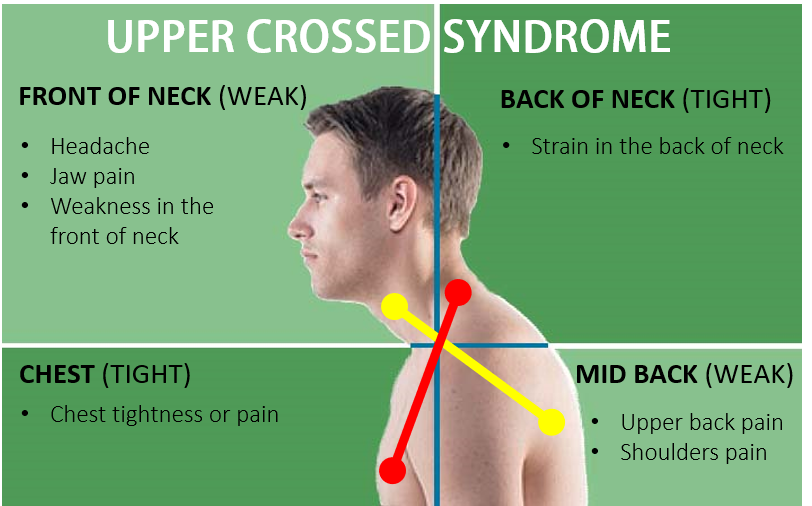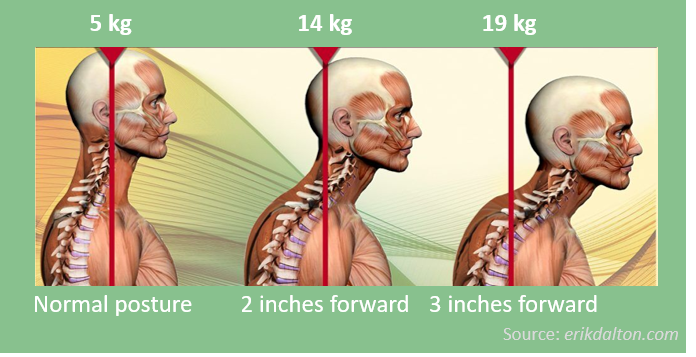Page Contents
In my previous blog article, we looked at sedentary lifestyle. In this and next articles, we will dive deeper into the poor posture of the upper and lower body, respectively. How are they related and get worse with sedentary lifestyle.
The most common posture problem for the upper body is Upper Crossed Syndrome, also known as handphone syndrome. It happens when the back muscles of the shoulder and neck become extremely strained, while the counter muscle groups at the front of neck are under-used and weakened. Same situation happens on the chest and back muscles. As a result of this, it causes poor upper body posture, which includes forward head posture, hunchback and slouching.
Causes of Upper Crossed Syndrome
A major contributor to this problem is sedentary lifestyle with continual poor posture. This can happen to anyone who has the following habits:
- Long hours of driving with seat and steering wheel that are not adjusted to the suitable height.
- White-collar workers who attend long and back-to-back meetings regularly.
- Desk-bound job, such as clerk, secretary, accountant, programmer, lawyer, customer service, call centre operator, etc.
- Students who spend hours on reading with poor posture.
- Binge-watching dramas and video streaming. Couch potatoes.
- Spending long hours using electronic devices (handphone, laptop, computer) for work or leisure (games, social media, texting, video, online shopping).
Postures and symptoms
People who are suffering from Upper Crossed Syndrome display a few unique postures:
- Head is often extended in a forward position.
- Cervical curve of the spine (neck area) is curving inward, while the thoracic curve (upper back and shoulders) is curving outward.
- Shoulders are elevated, rounded and protracted.
- Visible and protruding shoulder blades.

The poor postures described above could lead to various discomforts:
- Headache
- Neck pain (strain in the back, weakness in the front)
- Feeling chest tightness or pain
- Pain in the upper back, including shoulder blades
- Jaw pain
- Muscle soreness and tiredness
- Restricted range of motion in the neck, shoulders and ribs
- Numbness and tingling sensation in the upper arms
- Lower back pain
How to Prevent Upper Crossed Syndrome?
There are several precautionary measures that you can take to correct your posture and minimise your risk of getting Upper Crossed Syndrome.
- Be mindful of your posture whenever you walk, eat, sit, stand, rest, and sleep.
- Avoid being inactive for an extended period of time, such as watch television, using computer, reading, and driving. Take breaks in between the activities.
- Do cardiovascular exercise for 30 minutes a day.
- Do stretching and deep breathing to improve blood circulation.
- Strengthen your muscles in the neck, chest, shoulders, and back.
- Adjust your seat/chair, steering wheel, and monitor screen to suitable height.
- Engage in exercises such as Yoga, Tai Chi Quan, Pilates, swimming, badminton, basketball to stretch and strengthen your muscles.
Treatments for Upper Crossed Syndrome
There are several treatment options for Upper Crossed Syndrome. For example, massage, chiropractic alignment, physiotherapy, corrective exercises, and posture correction braces. An effective treatment applies a combination of different techniques.
- Massage therapy uses rubbing and kneading techniques and sometimes heat therapy to relieve tension of muscles through better blood circulation and relaxation.
- Chiropractic manipulation helps to restore natural movement and correct the misaligned joints. It relieves joints stiffness and allows muscles to pull the shoulders and back into alignment.
- Physiotherapy is a more holistic technique that involves assessment, patient education, stretching and strengthening exercises throughout a prescribed treatment period.
- Corrective exercises focus on stretching and strengthening of the weakened muscles at the anterior neck and mid-back.
- Posture correction brace is also commonly used as an assistive device to help maintain the correct posture.
Upper Crossed Syndrome is a common postural problem, unlike scoliosis and other degenerative vertebrae which have extreme spinal curvatures. Most of the time, it can be corrected with non-invasive techniques.
Conclusion
Sustaining prolonged poor posture causes imbalances and adds unnecessary pressure to the spine. Did you know you could easily add on extra 14 to 19 kg of weight to your spine for every inch your head moves forward from the shoulders?

Over time, Upper Crossed Syndrome can develop into chronic pain and spinal degeneration. It is wise to take precautionary measures or seek treatment early. As you age, your recovery is getting slower and you are more prone to permanent deformation of the spine. Starting today, be mindful of your posture.
In the next article, we will look into the other problem caused by poor posture, which is the Lower Crossed Syndrome. Stay tune!
